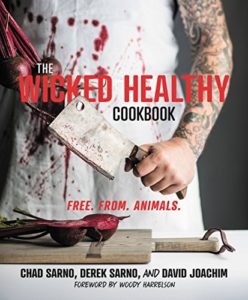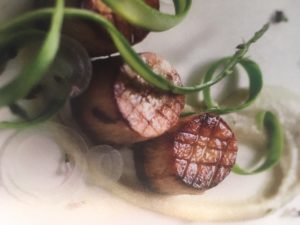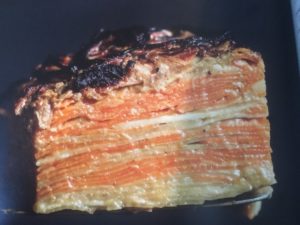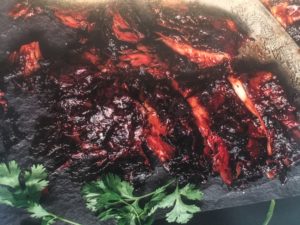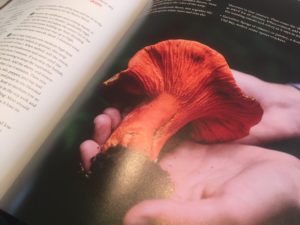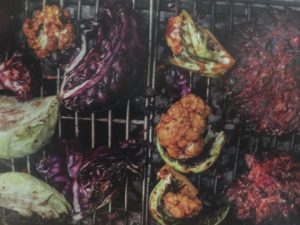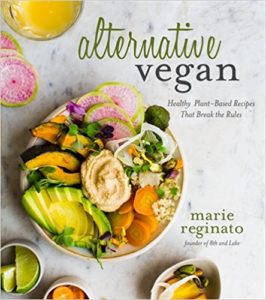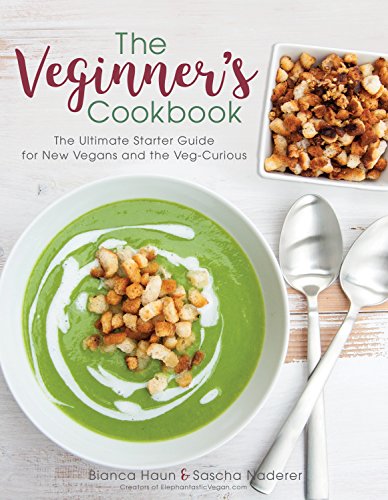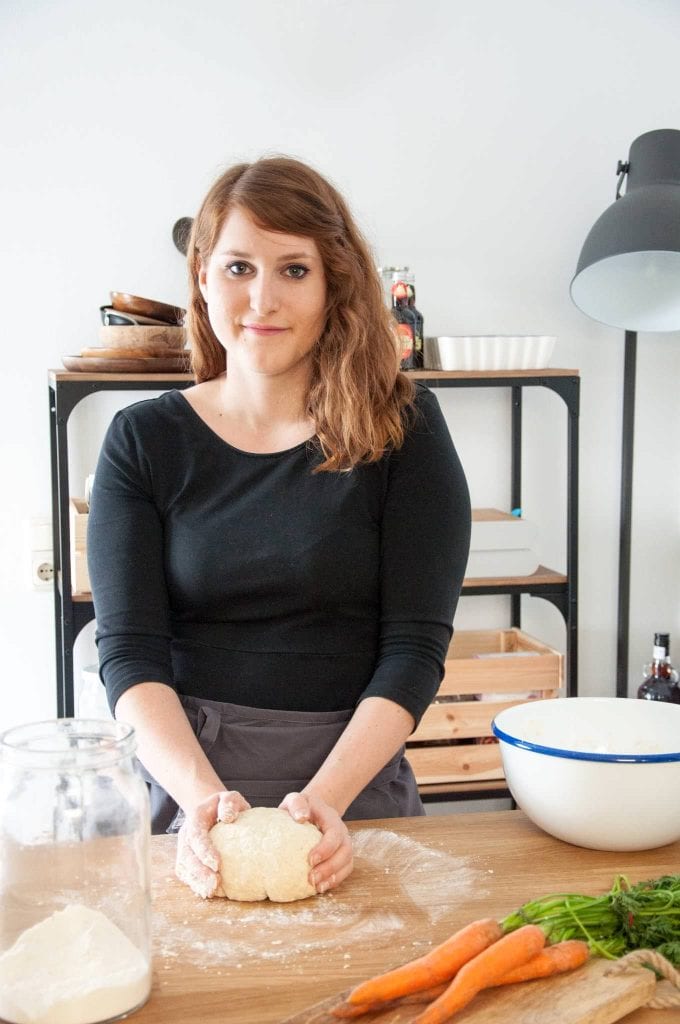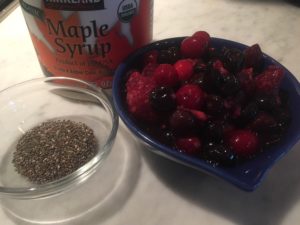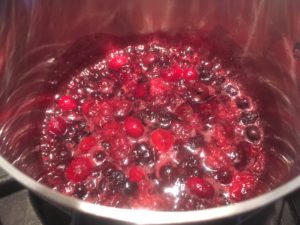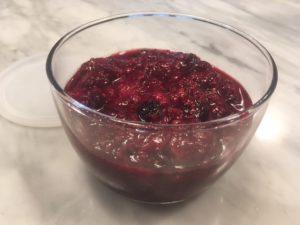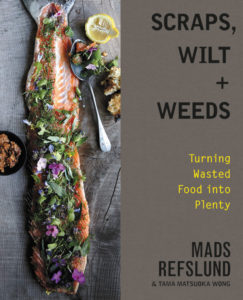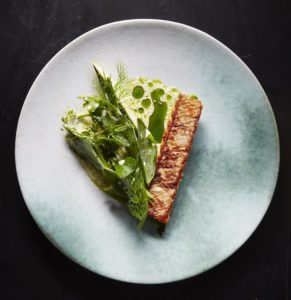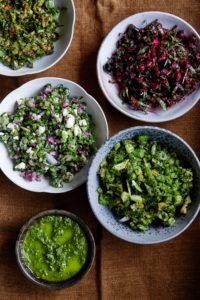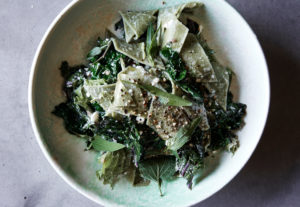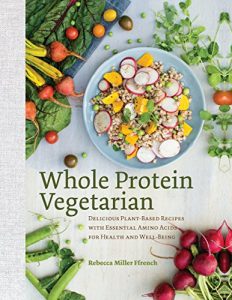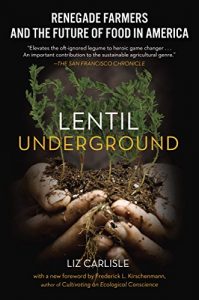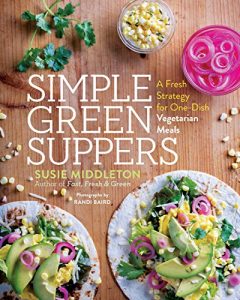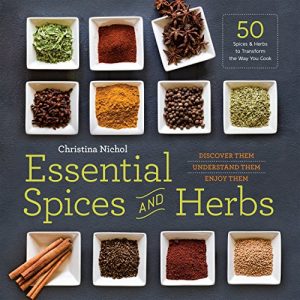Category Archives: Knowledge Is Power
What We Eat
“Eat food, not too much, mostly plants.” –Michael Pollan
After over a decade on a whole-foods, plant-based diet – with long-term forays into oil-free as well – we started to take stock and make some changes. Neither of us had lost any weight, despite a reasonable exercise regime – and didn’t feel as energetic as we’d like. We were also concerned about brain health, sufficient quality Omega-3s, and took a lot of cues from the lifestyles of the “blue regions.”
To be clear, we don’t believe that there is any one diet that works for everyone. But there are some basic underlying givens – organic and non-GMO to start. The Environmental Working Group’s Dirty Dozen (or 18) and Clean 15 list (ewg.org) is the place we start to decide where to spend our organic food dollars. To augment what we get weekly from our CSA.
To change from such a long-time vegan lifestyle was not easy, but we both agreed it was time, We started by just adding a little fish to our diet to ensure quality omega-3s. But not just any fish or seafood – we made a list based on, again, the Environmental Working Group’s (ewg.org) high omega 3s and low mercury list combined with the Monterey Aquarium’s sustainability list. Those lists have since been combined so there is now just one easy source (ewg.org). With a couple minor exceptions, these are all wild-caught seafood from sustainable populations. We also have a secondary list that is not particularly beneficial, but not particularly harmful – either to us or to the environment. Clams, shrimp, even the occasional lobster lands on that treat list – but still, all wild caught. Nothing farmed, except for Rainbow Trout or from the evolving totally land-locked aquaculture community.
Our friends were delighted! Entertaining us was now so much easier. To accommodate our diet, they happily centered meals on wild-caught Alaskan salmon and everyone at the table was content.
After a year or so, we decided to look further. While we had lost weight on five-day all-organic juice and smoothie fasts, we inevitably gained it all back. We both wanted to lose about 15 pounds – permanently – to be healthier, look better, and regain large swaths of our closets. So we needed to find a diet that was satisfying for the long term and would also help us meet our weight goals.
We explored many options to find an approach that was grounded in evidence with a science that made sense. We decided to try Mark Hyman’s 21-day “Eat Fat, Get Thin” diet. It was pretty much life-changing for both of us. We found it very easy to follow, never felt deprived and started to lose weight – slowly and consistently. After our experiences on an oil-free plant-based diet, and having been steeped for decades in “low-fat” and “a calorie is a calorie” propaganda, it was really hard to add all those healthy fats. But we did, and, for us, it worked.
Hyman adopted the newly minted “PEGAN” to describe his maintenance plan – the best of paleo and vegan – and we have embraced a lot of it permanently. We still don’t eat meat or fowl. But we have dramatically limited our grains and beans, have added lots of healthy fats, continue to eat small portions of wild-caught fish and seafood, and are both at – or very near – our goal weights. Our plates are about 2/3-3/4 vegetables, 1/8-1/6 protein (fish, tofu, etc.), with nuts, seeds, organic extra-virgin olive oil, and three specific kinds of cheese as condiments. We cook only with avocado and organic coconut oils, (and very occasionally with ghee and organic sesame oil). The Organic EVOO is always added after cooking.
The grains: Quinoa (actually a seed), black rice, wild rice, organic brown rice (only occasionally and cooked in a big pot of water like pasta), Italian Arborio rice, amaranth, and millet. We experiment with a little bread – mostly organic mixed seeds and grains (Dave’s Killer) and whole-grain gluten-free (Udi’s). And we limit pasta to GF quinoa, red-lentil, and Miracle/Shirataki Noodles (made with Konjac). Plus we also spiralize a lot of veggies, which we actually find very satisfying.
Dairy: We continue to use only organic plant-based milk (almond and coconut plus canned full fat coconut milk) and, for the most part, plain organic coconut and almond yogurts. But we have also recently toyed with grass-fed organic full-fat cows milk Greek yogurt (Stonyfield’s Totally Grass-Fed Organic plain Greek yogurt) – to see how we feel. As for cheese – this is a very personal list: Only authentic Italian Parmigiano Reggiano, authentic Greek Sheep’s Milk Feta and French goat cheese (Chevre). That’s it. We trust these European sources far more than American ones and can find them easily even in the big box stores (they just cost a little more).
At the same time, we are giving up most vegan cheeses because they seem to be so full of undesirable ingredients. But we are withholding judgment because of the new wave of clean plant-based dairy from Miyoko, Kite Hill and other local sources. But as of now, they are very pricey. We have stopped eating most of the ersatz vegan substitutes like sour cream, some of the yogurts, and butter-substitutes because they have very long ingredient lists filled with things that we prefer not to consume. To date, we have not been successful in making our own plant-based yogurt. But we will continue to try.
Eggs? Yes! Pastured, organic, free-range. Three times as much as supermarket CAFO eggs, but there is a real difference that you can see and taste. And the consensus, at least this year, is that the right eggs are healthful. So an over-easy egg on a mess of steamed power greens (baby chard, spinach & kale with a pinch of turmeric) drizzled with EVOO is the standard breakfast these days.
Sweeteners are confined to organic stevia, organic maple syrup, organic dates and organic strawberry jam – and an occasional drizzle of hyper-local honey from our neighbors’ hives. We also stock organic peanut butter, sun butter, and almond butter, along with an array of olives, capers, pickles, artichoke hearts and lots of other unctuously lovely foods. Umami comes from an assortment of mustards and five kinds of miso. We’ll leave a full panty list for another post, but suffice it to say there is very little processed food of any kind.
Beverages are mostly organic green tea, lemon filtered water, iced tea, an occasional glass of wine (and for my husband coffee and beer).
Bottom line, we rarely, if ever, feel deprived, and find it remarkably easy to dine out or be a dinner guest (we just get a little flexible and stay on course at home). We think that choosing what and how one eats should be a continually evolving process – informed by reliable, reproducible, evidence-based studies. That it is important to not get stuck with titles, or too invested in one’s food choices as a large a part of one’s identity – because then you feel less free to change. Try something that resonates and if it works, great. If it doesn’t, step back and try something else. (Oh, and BTW, my IBS which has informed my life for at least seven years has mostly disappeared……).
The Wicked Healthy Cookbook – Free. From. Animals. (Preliminary Review)
By Chad Sarno, Derek Sarno, and David Joachim
Grand Central Life & Style, Hachette Book Group, New York, NY 2018 $30
I love this book!!! From the minute it arrived, I was lost. Just skimming the essays, lists, Pro Tips and stunning recipes and images took me into the wee hours. Putting it down was not an option. Granted, my guilty pleasure is reading cookbooks. But this is a very special tome. Just when it felt like plant-based cuisine had reached its limits, with book after book adding a few new spins but churning the same ground, Wicked Healthy has seriously upped the ante. It’s fun, exciting, innovative, energetic, – the enthusiasm for the possibilities of plant-based gastronomy leaps off the pages. Dust off that mandoline!
To be clear this is not a book for every veg-forward cook. It is not an intro to the philosophy or a beginners’ guide. Some of the recipes are challenging, time-consuming and utilize esoteric ingredients that may require the resources of Whole Foods, Amazon, H-Mart, Thrive, a sophisticated farmers market and a few small mail-order houses – and even then you may have to be satisfied with recommended subs. It’s also, not surprisingly, a bit cheffy – many ingredients lists include other recipes so, unless you have a staff, there is sometimes serious time required. But it will be well-spent, satisfying time – even the process of discovering new or less-available ingredients will be well-spent, satisfying time. Bottom line, if all you do is just read The Wicked Healthy Cookbook, you can’t help but appreciate the expanded possibilities of plant-based cookery.
This is just my first review. I am going to cook my way through a good chunk of the book and post the results as I go. Starting with their bold new take on mushrooms: King Oysters, Maitakes, and Lobsters. What fun!! I can’t wait.
(One question – olive oil instead of avocado oil for high heat cooking?)
Alternative Vegan – Healthy Plant-Based Recipes that Break the Rules
By Marie Reginato
Page Street Publishing, Salem, MA. 2017
I love the sentiments and attitude in this book! After more than a decade on a relatively strict “whole food, plant-based” diet, we started a little rethinking – prompted by a series of research reports that stacked one question atop another. I worried about the quantity and quality of our omega-3 and protein intake. We were also feeling a little bored and needed to amp up the deliciousness of our food. We agreed it was time to break just a few of the rules: we added some pastured organic eggs, a little sustainable, low-mercury, high-omega 3 seafood and two specific European cheeses to our diet*.
A couple months later “Alternative Vegan” landed in my lap – encouraging the breaking of pretty much the same rules!
Aside from the affirmation provided by the author (saying just what we wanted to hear), this is a solid effort that adds variety and originality to the cookbook shelf – clear recipes that work, full-page, bleed images of every recipe that inspire, and a thoughtful approach to food in general. Wherever there is rule-breaking, the author provides a vegan alternative.
The recipes tend to depart from the expected which is, for those of us with dozens of plant-based cookbooks, a welcome relief. On the other hand, these are not “throw dinner together in a few minutes” recipes. Not even the 30-minute ones. The ingredient lists tend to be lengthy but not esoteric – if you’ve been eating plant-based for a while, you’ll find most of them on the pantry shelf. Cupboard Curry is just that and Minty-Pistachio Falafels with Tzatziki gives these old stand-bys a fresh flavor profile. Also welcome are two takes on sliced “pre-cooked polenta rolls” that get a yummy dish on the table quickly.
As a lover of dinner leftovers for breakfast, I found the Morning Glory Bowl even better; it’s a made-from-scratch, well-seasoned, Swiss chard, spinach, fennel, avocado and dill breakfast (or maybe brunch) dish. The recipes bounce between creative riffs on traditional favorites and some really unique ideas – and that originality extends to the unexpected chapter titles. There’s Breakfast and Dessert (Dark Chocolate with Lime Zest & Pumpkin Seeds!!) – but standard headings stop there. The chapter on Bento Boxes and Buddha Bowls adds some new perspectives as does the Ex-Rated chapter on pizza and pasta. But the main events are mostly in Eating on the Vedge.
I do take issue with some of the “alternative” choices – IMO, eggs should be “pastured” as well as organic and the seafood choices should align with the Environmental Working Group’s detailed assessment of sustainable, low-mercury and high omega-3s. But those are my personal choices and all of the seafood recipes will work just fine with other species …..
*The specifics of our alternative choices are covered in the post – “Shhh! We’ve Decided to Break a Few Rules!”
The Veginner’s Cookbook – The Ultimate Starter Guide for New Vegans and the Veg-Curious
by Bianca Haun and Sascha Naderer
Skyhorse Publishing, January 16. 2018
My first reaction to this beautifully photographed, inviting tome was “What a great name! How come no one else thought it?” And it is actually a perfect name. This is a nicely done intro to vegan food. If you have been cooking and eating a plant-based diet for a while, or are deep into the various nutritional perspectives, you might not find a lot new here. But if you are thinking about dipping a toe in the vegan waters, it’s a very solid beginning.
All of the culinary bases are covered; the authors provide a current overview of the plant-based landscape – and have even included a couple of “finds” like kala namak (Himalayan black salt) for an eggy taste. The full-page color photos of the finished dish are excellent – and really required for beginners. The goal is clearly to ease the first-timer into the concept of meat and dairy-free cooking and eating without adding the additional challenges of limiting some oils or using only whole grains and whole-foods. It is a reasonable approach.
The authors, Bianca & Sascha, are an Austrian couple who are passionate about their relatively recent adoption of veganism and share their experiences on their blog ElephantasticVegan.com as well as in this new book. They also provide a little hard-won guidance for newbies who are navigating the sometimes treacherous social waters of “well a little won’t hurt, will it?” or “where do you get your protein?” Sascha calls it the “Landmine Situations.”
We also appreciate the Bianca’s Kitchen Hacks that are scattered throughout the book. These are little hints for the newbie and some additional thoughts for the more experienced.
Be aware: The nutritional philosophy that underlies their book is straight-ahead vegan (as opposed to whole-foods, plant-based): veggies, grains, nuts, seeds, oils (especially canola oil* – which is concernful). You won’t find a lot of whole grains, gluten-free or sugar/sweetener-free recipes. Their main concern with white sugar, for instance, is that it is vegan (and not made with bone char) rather than that is may be very bad for your health. Baking begins with white all-purpose flour with a nod to some options (that said Healthy Breakfast Muffins are made with oat flour). That is not a criticism as much as a buyer-aware alert. (Also for recipes that contain miso, be sure not to let it boil or you will kill off the probiotics.)
We love the Small-Batch Strawberry Chia Jam – quick and easy and delicious (so convenient when you discover you’ve just run out – see images below). The last time I used frozen organic mixed berries with a smidge more maple syrup. And the curries are inventive and easy, as well. The Hummus Four Ways are strikingly beautiful and the Shake and Bake Sweet Potato Fries inspiring (a keeper in this house)! Love the banana-based “Nice Creams”, too. I am surprised by the canned lentils in the Thyme Lentil Soup (unless you are on a Low FOD-MAP diet). Dried lentils would have taken just another 15 or so minutes.
Bottom line: This would make a great gift for someone who has expressed interest in experimenting with a plant-based diet. The recipes will be successful and delicious – and visually appealing. It will get most people over the hump and show them that this is a viable diet. And, even if they don’t go the whole way, they will have found a lot of recipes that will stay in their rotation no matter what.
(*Canola Oil – perhaps the canola oil available in Austria is less tainted than what we can get in the US. I substituted Avocado oil or Coconut oil for the canola oil in the recipes that I tried. Also subbed tomato sauce or tomato puree for tomato passata.)
Glorious Food Waste
For decades, I have been gently chided, and occasionally mocked, for my kitchen frugality. A drawer filled with wilting produce sets off a visceral reaction leading to aggressive cooking. I don’t think it’s cheapness, as much as it’s a deep-seated concern about waste. Over the years, cooking teachers have denigrated the big, re-purposed Ziplock in my freezer chock full of plant scraps and leavings; apparently only pristine produce is good enough to make vegetable stock or fruit sauces. But still I persisted because, frankly, that just didn’t make any sense to me. And, besides, I just can’t empty that seemingly still good food into the trash or compost heap.
A short while ago, I stumbled on a wonderful “cookbook” Scraps, Wilt + Weeds written by Mads Refslund and Tama Matsuoka Wong. Refslund was a co-founder of world-famous Danish restaurant, Noma, and, shockingly, shares my visceral reaction to wilting, near-rotting produce! But he goes many steps beyond just making vegetable stock, dry-roasting just-past-prime produce, stewing less than perfect fruit into sauces and, of course, freezing very ripe bananas for breads and smoothies. Mads Refslund has elevated waste to haute cuisine.
The concepts are invigorating and inspirational – with stunning photographs that make near garbage extraordinarily beautiful. I use the word concept advisedly – to me the recipes are more conceptual than standard “multi-user-tested” ones. This is relatively new turf and the reader needs more guidance as to when, for instance, a tomato is near rot or just plain rotten. Even though I am a fairly accomplished home cook and long-time rescuer of wilted produce, I often had questions. For instance, a couple years ago I made carrot-top pesto from gorgeous, young CSA carrots and it was so bitter, it was inedible – why wasn’t his?
On the other hand, he encourages flexibility – use what you have (less, more or sub something else) rather than create more waste by buying to meet the specific recipe requirements. Other chapters focus on buying “ugly” produce, foraging for “weeds” and even using discarded fish parts. All told, it is a glorious paean to the minimization of waste and as I reluctantly released my non-renewable library copy, I concurrently added it to my Amazon list.
Mads Refslund has vindicated my kitchen frugality while he introduced others on whose shoulders he stands; those who have been long proselytizing waste reduction but who did not have his bully pulpit**. He has made reducing food waste sexy and chic. What a stunning, unbelievable accomplishment!! This is a book to own – a reference to stiffen our spines and alter our perceptions when we are about to sweep the leavings into the Waste King or the compost pot.
Why is this book so important? Every year, roughly 30% of all the food raised on the planet for human ingestion is literally wasted. If you just look at first world countries that number is even higher with the U.S. leading the pack at over 40%. According to the World Economic Forum, our global population is projected to reach 9.6 billion by 2050 – raising the leading question: how do we feed everybody? The United Nation’s FAO (Food & Agriculture Organization) posits that we already grow enough food, we just have to figure out how to save that 30-40% that we are currently wasting – which represents about 28% of the earth’s agricultural land. A whopping 25 percent of that waste is imperfect produce left in the fields to rot and 15% comes from tossed out, perfectly edible, food. (An additional, crucial, benefit would be to save the carbon footprint of all that wasted food –according to the EPA, landfills account for 34% of all U.S. methane emissions.)
** I am reading some of the author’s references and will share reviews and content in future posts.
My Take on “Veganism”
Up until a dozen years ago, we’d been innocently and happily eating a whole-foods, sugar-free, “healthy diet” for about three decades; it included low-fat dairy, white meat chicken and fish. But then, my husband “pushed through” on a New York Marathon feeder race, collapsed and was unceremoniously hauled off to a local hospital. That was when we learned that he had plaque on his arteries! I took this as a personal affront to my hard-won nutritional knowledge and culinary expertise.
After listening to my angst-ridden breast-beating, a friend handed me the “Eating” DVD (3rd Revision) – it was a revelation. The interviewees weren’t McDonald addicts or slab-of-beef on the plate types; these were people who’d been eating just like us. And their health profiles were just like ours. Once they embraced a whole-foods, plant-based lifestyle – aka veganism – their health improved: plaque disappeared from arteries, insulin requirements nose-dived, weight slid off…… We were smitten and embraced this new life-style with vigor and enthusiasm.
Today we’re still eating a primarily plant-based diet. We know that we’re healthier with it, that animals suffer less because of it and that the planet is better off (we could trade our Prius for a Humvee and our carbon footprint would still be impressive). But we’ve lost the religiosity. We prefer the term WFPB over Vegan because it is not so loaded. We still use the terms vegan or strict vegetarian in restaurants because plant-based does not compute with servers. But to the rest of the world, we call it a whole-foods, plant-based diet.
Over time, we’ve gotten easier with it. When we travel or dine out – especially at friends’ homes – we expand our options to include wild-caught salmon, mussels, oysters, brook trout and a couple other low-mercury, high omega-three, sustainable species (kudos to the Environmental Working Groups for simplifying this). Blue crab and lobster also make the few-times-a-year list because there are Crab Feast and Lobster Bake traditions on both sides of our families. On occasion, we also eat free-range “humanely raised” eggs. It makes life easier for everyone and, frankly, we welcome these occasional additional options. That said, when we are home, we eat a pretty strict WFPB diet – we like it; it’s easy and it allows us to “regroup” especially after long bouts of travel. When we entertain, it’s almost always a WFPB meal as well; we work hard at delivering luxuriously delicious meals that usually end with a dark chocolate dessert – and, hopefully, make the lack of animal products unnoticeable and irrelevant.
We don’t proselytize and only discuss our food choices when asked; we hope that this low-key approach might make the plant-based concept less off-putting and more appealing. It seems to us that the fewer animal products one eats and the more organic produce one consumes, the better off everyone is (for organic, we shop with the EWG’s Dirty Dozen [actually 20] and Clean Fifteen lists). As Columbia Professor Emeritus Joan Dye Gussow would say to the “Earth Friends” fourth graders: “it’s better for both worlds you inhabit – your body and your planet.”
We are fans of Meatless Mondays, Mark Bittman’s “VB6” (Vegan Before 6 pm), and any other variation that encourages people to dip a toe into this lifestyle. This is not a religion; it is a choice that is a win-win-win for you, for the animals, for the planet. Our philosophy is: just do what works for you; no one is taking notes.
Whole Protein Vegetarian – Delicious Plant-Based Recipes with Essential Amino Acids for Heath & Well-Being
By Rebecca Miller Ffrench. The Countryman Press 2016 $27.95 (Amazon $18.50/ Kindle $14)
Ms. Ffrench approaches recipes and daily menus from the very particular perspective of amino acids – in other words protein. There is a mantra in the plant-based world that it’s impossible not to get enough protein. That we actually consume too much protein and the invariable question from the canivores “how do you get your protein?” is mock-worthy.
But the author demonstrates that that might not be as true as we had assumed I was surprised when taking a hard look at the protein counts of some of the pulses and vegetables that we normally consume. If adequate protein is a concern, then this might be a useful reference.
It’s a handsome, hard covered book with bleed and full-page photos of about half the recipes. The recipes themselves are not particularly adventuresome or noteworthy – assuming you are steeped in current plant-based culinary arts. If you are not, then this is an excellent primer. I prepared a couple and they were fine family-dinner fare – but not guest material.
The Lentil Underground – Renegade Farmers and the Future of Food in America
by Liz Carlisle, Avery 2015 $16 (Amazon $12)
An improbable group of renegade Montana farmers, led by David Oien, a former philosophy student, fight against Big Ag, local conventional farmers, GE seeds and worn-out soil to launch a sustainable business. Oien decided to return to his family’s 280-acre farm and, defying the regional orthodoxy, grow organic lentils – the edible seeds of plants that return nutrients to the soil.
Generally considered part of a family of weed crops, lentils are actually a very marketable commodity; they’re an inexpensive protein that’s rich in fiber, B1, folate, and amino acids, that doesn’t require irrigation and makes its own fertilizer. But marketing this Big Sky strain of organic small, black Beluga lentils to other potential growers as well as to the country’s distant taste-makers became the challenge. He needed help and that support emerged from unexpected places.
A number of remarkable farmers and other characters populate this tilting-at-windmills drama including buttoned-up, financial whizzes Doug and Anna Crabtree, the conservative Christian homesteading Manuel family, Senator-Organic farmer Jon Tester, eco-friendly builder and jack-of-all-trades Bud Barta along with a half dozen others. With their help, David Oien founded Timeless Natural Foods and grew it into a million dollar business that includes several unique lentil products and a full complement of other high-end quality grains.
To do that, he first had to convince chefs to try his lentils and then put them on their menus highlighting these unique Beluga Lentils. Word spread within the culinary world which netted Oien contracts with Trader Joe’s and Whole Foods and hundreds of smaller healthy food stores (some of which came with hard lessons and losses). But Orien persevered and his network of growers stood by him.
Almost as interesting, is the story of the book’s Montanan author: Harvard & UC Berkley trained, former country singer Liz Carlisle also served as Legislative Correspondent for Agriculture and Natural Resources in the Office of U.S. Senator Jon Tester. Today she is a Lecturer in the School of Earth, Energy, and Environmental Sciences at Stanford University, where she teaches courses on food and agriculture, sustainability transition, and environmental communication. Dr. Carlisle approaches her subject “The Lentil Underground” by integrating deeply-felt stories about the pioneers who risked all to farm holistically with clear, exceptional essays on the science of farm ecology.
Simple Green Suppers – A Fresh Strategy for One-Dish Vegetarian Meals
by Susie Middleton- Roost Books April 11, 2017 $24.95 (Amazon $14)
This is, as the title promises, a book of vegetable forward family dinners that strives for the unctuousness of meat-meals, the delciousness of deeply layered flavors, and the freshness of right from the garden produce. It is a beautiful tome, with lots of enticing full-page bleed photos from Randi Baird, that makes you want to dive in and start cooking
Ms. Middleton approaches the organization of her one-dish family suppers from an unusual perspective; each chapter focuses on a specific, but varied, base to which veggies are added: noodles, grains, beans, leaves, toasts, tortillas, eggs and broths. And each of those bases covers the whole landscape of, for instance, noodles – soba, udon, rice noodles, pasta, couscous, somen, egg. If you “go with” this horizon-broadening perspective, it can really step up the nightly dinner grind – and add some fun to the shopping and prep. Each chapter is preceded by a couple pages of useful “Tips and Strategies” – including prepping your larder. These aren’t ten minute projects and the ingredient lists can be a little bit daunting, but most can be executed well within an hour – and the results are far from fast food. There are some new concepts and fresh, upgraded re-works of old favorites.
But be aware this not a totally plant-based book. There is a chapter, as noted, on eggs and some dishes in other chapters include cheese and dairy. But most of these ingredients are, IMO, easily substituted with vegan replacements since they are not center stage – or simply skipped. The egg chapter may be doable with the new Follow Your Heart VeganEggs (if you don’t have an issue with a primary ingredient – algal).
Note that the number of servings varies from two to three to four. So that means doubling or halving depending on your situation. As an empty-nester, I welcome recipes for two since I often find myself cooking the whole recipe for four – and then there are often no leftovers! The scale speaks.
I am looking forward to cooking my way through this lovely book and will post some of the results – especially when I’ve used dairy or egg replacements.
Essential Herbs and Spices – Discover Them, Understand them, Enjoy Them
By Christina Nichol – Rockridge Press 2015 $18.99 (Amazon $15.82 Kindle $4.99)
While not talking specifically to the plant-based cook, Ms. Nichol provides a useful overview of these critical components for all food preparations – not just for enhanced deliciousness but also for health promotion (almost all have “antioxidant, antiviral, antiviral, or anti-fungal properties”), ceremonial rites, preservation and, historically, that biggie: covering up the taste of foods on the verge of rot. Herbs and spices figure prominently in the age of exploration – when, ounce for ounce, some were as valuable as gold. And the discovery of others changed the flavor profiles of major cuisines.
What are herbs and spices? They are all some kind of plant. If used for medicinal purpose then the entire plant is referred to as an herb. But for culinary uses, the leaf (fresh or dried) is the herb and the stronger, more pungent seed, root, berry, bark, and flower are the spices. Herbs are at their best fresh and tend toward “bitter astringent, tart or savory” while spices are better dried with “earthy, nutty, warm” and pungent profiles.
The author makes a good case for knowing more about the history and contemporary usefulness these small bottles of big flavor stacked in our pantries. She focuses on a selection of 50 popular herbs and spices as well as ten useful blends – helping the cook triage if s/he isn’t ready to stock them all. Each is described along with its history, kitchen methods, healing uses, what foods it complements and what other spices and herbs it pairs with followed by a couple of concrete recipes.
Exploring the magic that these condiments can exert over the most plebeian dishes, may make the temptation to take the plunge to stock them all irresistible. Ms. Nichol also lists the critical herbs and spices of major cuisines: Cajun, Caribbean, Chinese, French, Indian, Italian, Korean, Mexican, Middle-Eastern, North African, Thailand and Turkish. I found this particularly useful when cooking without recipes – just pick a favorite flavor profile then pull out the particular jars that deliver it. Then play.
I have a spice cabinet containing well over a hundred herbs and spices and a pullout with two dozen ethnic mixes – but I still learned a lot from this book:
Whole spices can last up to 4 years, most ground spices up to three years and dried herbs up to two – contrary to prevailing myth to toss all at the one year mark. But always smell and taste your spices first to be sure. Then toast them
Red pepper spices increase in intensity during cooking! Beware
Asafetida is a vegetarian gift with a taste blend evocative of garlic, shallot, onion and leek that imparts that meaty, umani flavor. Love it but never knew why! It’s the dried sap of an herbaceous plant from the fennel family and also a wonderful gift for those with a sensitivity to the allium family.
